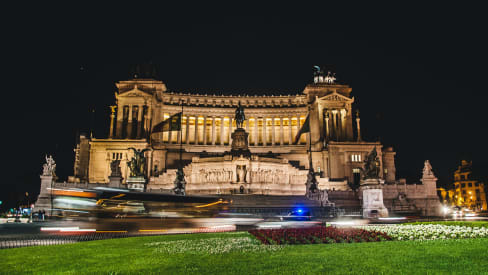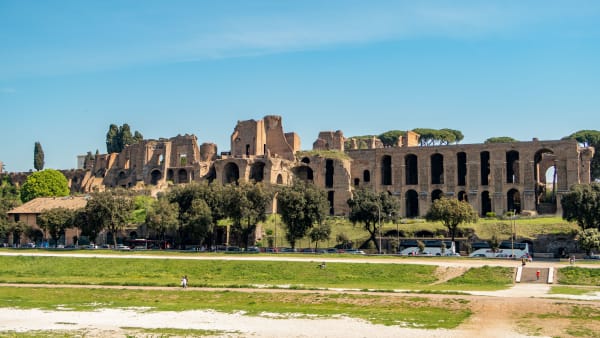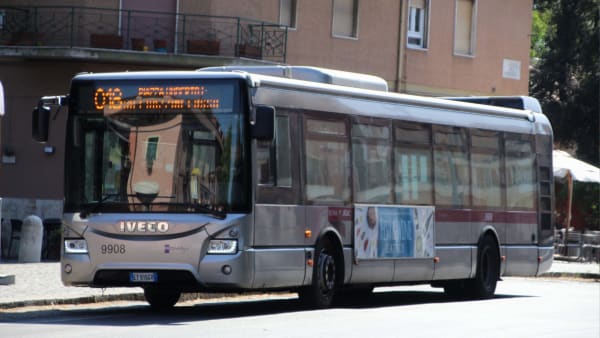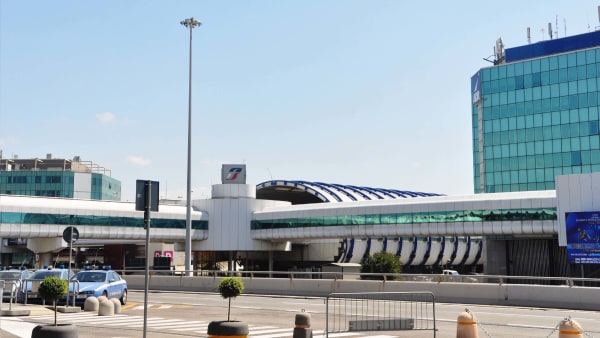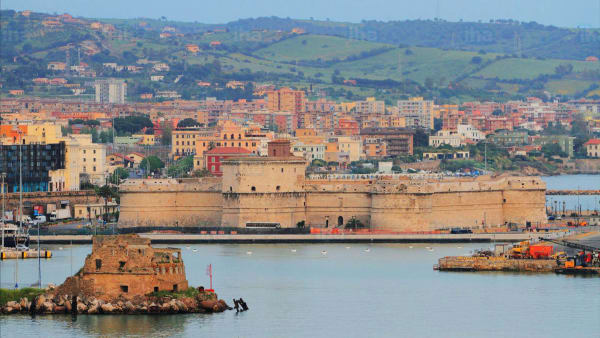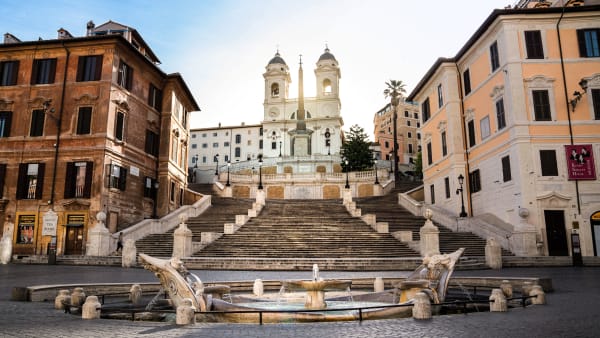Statues and monuments
Statues and monuments
Some of the most relevant monuments have been mentioned in the historical section of this article and they will now be discussed in more detail. Keep reading to understand the symbolism behind the many statues and works that adorn the Vittoriano. Here you will also find out which part of the Vittoriano, in particular, is called the Altar of the Fatherland, and which are its elements.
Victor Emmanuel II’s Equestrian Statue
Victor Emmanuel II’s equestrian statue, the centerpiece of the whole Vittoriano, was designed by Enrico Chiaradia, an artist discovered during the 1884 call for proposals. The piece recalls Marcus Aurelius’ equestrian statue. The work was built in honor of the late king of Italy (the first one the country as we know it today ever had).
Its construction began right after the king’s death, but it was completed only in 1927. It is one of the most impressive statues in Europe. It measures 12 meters in height and 10 in width. The bronze statue represents the king, in military clothing, riding a steady horse.
It is the biggest statue in the city, considering the marble pedestal, which completely makes it 24 meters tall. To make it, 50 tonnes of bronze were melted - that’s a lot of Royal Army cannons.
It is said that the city authorities organized a party to celebrate the moment in which King Victor Emmanuel III (Victor Emmanuel II’s grandson) would see the statue for the first time. The 21 people involved in the construction process were invited. The table set for them was the belly of the statue’s horse.
However, it seems that Sacconi was not satisfied with Chiaradia’s choices, as he deemed his artistic language too realistic, and thus not compatible with the neoclassical style of the rest of the Vittoriano. The statue, after Chiaradia died in 1901, was completed by the Florentine artist Emilio Gallori. Once it was put on its pedestal, the public was well happy to recognize the late king.
The City’s Statues and the Liberated Regions
The equestrian statue rests on a base on which 14 allegorical female figures are placed. The figures, sculpted by Eugenio Maccagnani, represent illustrious cities and the liberated regions of Italy. Turin is surely the city that plays a major role in this composition, having been the first Italian capital and hometown of the king himself.
The other cities are the so-called Noble Mothers, that is the capitals of the old Aristocratic States of the Italian peninsula, converging towards the Kingdom of Italy and the Savoy dynasty. Each one of them carries its own symbols, and among them, we can find: Florence, Naples, Amalfi, Pisa, Ravenna, Bologna, Milan, Genoa, Ferrara, Urbino, Mantua, Palermo, Venice.
A special place was also dedicated to the victorious armed forces who fought in the unification process. These statues are the Engineers, Navy, Artillery, and Cavalry. Maccagni represented them at the bottom of the base, inspired by a similar composition in the Trajan Column.
As for the statues of the regions of Italy, they are located on the frieze of the apex of the portico, on the cornice, each in correspondence with a column. There are 16 of them, like the number of Italian regions at the time of the monument’s construction.
Based on the type of frieze and the height of the statues, we can see the reference to the nearby Trajan Forum. Each statue is five meters tall and each was entrusted to a different sculptor, almost always a native of the region whose image he would carve. The cornice is also embellished with eagles and lion heads.
The names of the regions represented, as well as the selected regions themselves, have changed with time, so many of the names of the statues do not correspond with the current Italian regions.
For instance, the region of Emilia-Romagna, at the time was simply called Emilia, and the region Basilicata was known as Lucania. The regions of Abruzzo and Molise are instead represented by the one region that existed at the time. Another example is the area of the Triveneto*,* which is represented by one statue (the regions are today three: Veneto, Trentino-Alto Adige, and Venezia Giulia). The regions of Valle d’Aosta and Piedmont, are also represented by a single statue, as they were under the same juridical entity.
The Statue of the Goddess Rome
Under the king’s statue, at the center of the Altar of the Fatherland, we can find an extraordinary female figure, inspired by Athena, the Greek goddess of Wisdom, known as Minerva in the Roman pantheon.
The statue represents the Goddess Rome, a large votive altar dedicated to the Italian nation, designed by the architect Giuseppe Sacconi and built by the sculptor Angelo Zanelli between 1911-1925.
Inside the shrine with a gilded mosaic background, the goddess stands in typical Roman dress and goatskin. She wears a helmet and crown with wolf heads, a spear in her right hand, and a statuette of a Winged Victory in her left.
The Stairway and its Sculptures
The magnificent staircase is a fundamental element of the Vittoriano, just like its three-level structure with lots of open spaces for visitors. These allow us to walk among the monuments, among which the majority is heavily symbolic of Italian history.
The stairway leads us from Piazza Venezia to the terrace of the Altar, then to the terrace of the liberated cities, and finally to the terraces of the two propylaea, which flank the summit portico and form the two entrances.
The entrance gate, which is 40 meters long and weighs 10,500 tonnes, stands right in front of the stairway. It was made by Manfredo Manfredi and it can slide on the ground thanks to the tracks that the architect designed.
At the sides of the main entrance are two fountains: on the east side we find the Adriatic Sea fountain, by sculptor Emilio Quadrelli, on the west side is the Tyrrhenian Sea fountain, by Pietro Canonica. Both the statues, built between 1908 and 1911, are inspired by the river statues placed by Michelangelo in the Campidoglio square.
Next to the entrance stairway, there are several statues that lead the visitors towards the Altar of the Fatherland. The first ones are two gilded bronze sculptural groups, with subjects inspired by Giuseppe Mazzini (Italian unification patriot, politician, philosopher, and journalist).
They are Thought and Action (respectively to the left and to the right, for those that leave Piazza Venezia behind them). After them, the other two sculptural groups follow. Here too there is one for each side, both Winged Lions. Finally, at the top of the stairs, before the Altar’s terrace, are two Winged Victories.
The choice of these characters is tied to a strong symbolic meaning. Thought and Action have been two important elements in the process of unification, both drivers of historical and social change. The sculptures’ shapes remind us of their characteristics. Action has an angular profile, while Thought is more circular.
More in detail, we can see a bronze Winged Genius (by Giulio Monteverde) representing Thought. He rests his hand on the personification of Wisdom, from whom he takes allegorical inspiration, and who helps The People to rise, incited by the goddess Minerva. The composition is completed by the figures of the Genius of War, sharpening his weapons ready for battle, and Discord, holding a torch and a scourge. Tyranny is now at the end of its tether.
Action, created by Francis Jerace, is represented by a group of Savoy soldiers raising the flag, upon which the words Italy and Victor can be read. Meanwhile, a Venetian Lion is taking down the oppressor, a woman holding a club is ready to hurl herself at the enemy and a young Garibaldian is preparing to attack. The latter is the only figure, aside from that of the king, to wear modern clothing.
The two Winged Lions, by Giuseppe Tonnini, are two marble statues representing the initiation of patriots who decide to join the unification enterprise motivated by ardor and strength, which also control their instinctive side (the animals are crouching on the balustrade).
The bronze Winged Victories, by Edoardo Rubino and Edoardo de Albertis, symbolize the military and cultural success of the Roman era, as well as good luck.
The Altar’s Terrace and its sculptural groups
Right after the Winged Victories, we enter the terrace of the Altare della Patria, the first elevated platform of the Vittoriano, which is dominated centrally by the statue of the goddess Rome, and the Tomb of the Unknown Soldier.
Also on the terrace of the Altar of the Fatherland are the sculptural groups in Botticino marble that symbolize the founding values of the young kingdom of Italy. The four are 6 meters high and are located to the right and left of the entrance to the terrace of the Altar, two on each side.
They are placed to the side of the statues of Thought and Action and in correspondence with the fountains of the two seas, along the parapets facing Piazza Venezia. This is no coincidence: the concepts expressed by these four sculptural groups, Strength, Concord, Sacrifice, and Civil Right, are the consequent derivation of the two statues mentioned above.
The triangular, sharp-edged Strength, by Augusto Rivalta, is situated to the left of the parapet above the Adriatic fountain. The statue is represented by a young and mighty Roman centurion dominating a medieval archer, and by a worker holding a pickaxe.
Again, the choice of subjects is not random: the Middle Ages were a time when Italy, as we know it today, did not exist, but consisted of many small, divided States. In Roman times, however, the nation was united under the rule of the empire.
The Concord, by Lodovico Pogliaghi, is located to the right of the parapet above the Adriatic fountain. It is represented by a central female figure with a cornucopia accompanying a Roman senator, who represents Princedom (i.e. the Savoy monarchy), and a young man, who instead symbolizes The People.
Another sculpture that emerges is that of the Family, in the guise of a woman holding a child in her arms, representing the birth of the new State. In general, the sculptural group metaphorically considers the birth of the Kingdom of Italy as an understanding between the Savoy monarchy and the Italian people.
Sacrifice, by Leonardo Bistolfi, is to the left of the parapet above the Tyrrhenian fountain. The sculptural group is made up of four figures with a dying young fighter in the center, supported by a freed slave (with the chains on his wrists broken) a symbol of the regaining of freedom and dignity. These are obtained thanks to the sacrifice of the Warrior, who receives a symbolic kiss from the Genius of Liberty, leaning towards him.
The sculptural group is completed by a woman who personifies, once again, Family: women, during the unification period and elsewhere, were seen as one of the most important examples of sacrifice, as they had to sacrifice themselves for the good of the family unit. The statue as a whole is connected to the previous sculpture, Strength, as the latter is indispensable to find within oneself the spiritual energy needed to make sacrifices.
Civil Right, by Ettore Ximenes, is located to the right of the parapet above the Tyrrhenian fountain. In the center is Freedom, who has just pierced Tyranny with a sword. Civil Right, meanwhile, looks at her as if to claim her role, rejected by totalitarian governments. The figure representing The People is supported in its fight for the national cause.
The Sommoporticus and Propylaea
The Sommoporticus is the portico of the Vittoriano, so-called because of its high location. It has already been mentioned earlier in this article, as it houses the frieze in which the 16 statues representing the symbols of the Italian regions appear.
It is 72 meters long and is crowned by 16 columns, each 15 meters high. The ceiling was designed by Gaetano Koch in 1907 and finished two years later by Giuseppe Tonnini, decorated with paintings and allegories representing the sciences.
Both the summit portico and the propylaea make up the highest point of the Vittoriano.
Each propylaeum (portico in front of the gates) is dominated by two bronze statues of chariots. These are two-wheeled chariots drawn by four horses, driven by Winged Victories, bearers of divine victory in battle.
The two chariots bear Latin inscriptions. ‘CIVIUM LIBERTATIS’ on the right and ‘PATRIAE UNITATI’ on the left. The first metaphorically symbolizes the freedom of citizens and is the work of Paolo Bartolini. The second is an allegory of the unity of the country and was created by Carlo Fontana.
Thanks to two triumphal entrance staircases, which are located on a platform connected to the terrace of the liberated cities, it is possible to reach the interior spaces of the sommoporticus and the propylaea.
At the base of the entrance stairs to the propylaea are four statues of Winged Victories on triumphal columns, built in 1911. In front of the left propylaeum is the Winged Victory with Palm and Serpent, by Nicola Cantalamessa Papotti. To the right of the left propylaeum is the Winged Victory with Sword by Adolfo Apolloni. Opposite the right propylaeum, on the right and left respectively, are two Winged Victories with Laurel Wreaths by Arnaldo Zocchi and Mario Rutelli.
The interior spaces of the propylaea are also decorated with metaphorical representations of virtues and sentiments in the form of mosaics.
The decoration of the ceiling of the left propylaeum was entrusted to Giulio Bargellini, whose mosaics figuratively represent four figures. One is Faith, rendered by the depiction of the people consecrating their children to the homeland, with a city reminiscent of Jerusalem in the background. Another is Strength, a warrior accompanying a young man to a meeting with a woman armed with a sword. And the last two are Work, personified by a family of farmers, and Wisdom, represented by a teacher in a chair in front of his pupils sitting at their desks.
The decoration of the ceiling of the right propylaeum was entrusted to Antonio Rizzi. He depicted Law, composed of allegories of Justice seated on the throne, Wisdom, Wealth, Prudence, Fortitude, and Temperance, each with their own distinctive characteristics.
We then find Valour, a young man tempering his sword on the wings of Freedom and surrounded by the founders of the Italic race, including Aeneas and Ascanius. Then is Peace, a female figure holding a sheaf of wheat and other figures bearing the fruits of the earth; and Union, given by the encounter between a young man and Poetry.
The inner doors leading from the two propylaea to the summit portico are adorned with allegorical sculptures representing the arts. Architecture and Music by Antonio Garella are located in the left vestibule. Painting and Sculpture, which are located in the right vestibule, were made by Lio Gangeri.
The interior of the vestibule has a paneled ceiling which, as mentioned above, was designed by Gaetano Koch, called the “ceiling of science”. The latter owes its name to Giuseppe Tonnini’s bronze sculptures representing the Allegories of Science.
They are female figures representing the sciences: Geometry with compasses and a square; Chemistry with a retort and a still; Physics with a lantern and a barometer; Mineralogy with a quartz crystal; Mechanics with a cogwheel; Medicine with a cup and Asclepius’ cane, Astronomy with a zodiac globe and Geography with a protractor and a globe.
Other sculptures in the portico are the Trophies of Arms, consisting of a set of shields, cuirasses, halberds, lances, flags, arrows, and quivers. One trophy shows the emblems of the House of Savoy, that is the crown of Italy: the eagle with the cross shield and the collar of the Annunciation.
The Altar of the Fatherland
The Altar of the Fatherland, located at the top of the entrance steps, is a large votive altar to the nation and is the most well-known part of the Vittoriano. It is so well known that the entire Vittoriano monument is often referred to as the Altar of the Fatherland.
The statue of the goddess Rome, in the center, dominates the altar together with the Unknown Soldier. The project was designed by the same architect as the Vittoriano, Giuseppe Sacconi, and executed by the Lombard sculptor Angelo Zanelli.
Zanelli won a call for proposals which was launched in 1906 and was still in progress when the Vittoriano was inaugurated on 4 June 1911. Zanelli’s design, presented at the time, won public acclaim over the other finalist, Arturo Dazzi. Zanelli then delivered the work in 1925.
In addition to the Goddess Rome and the Tomb of the Unknown Soldier, there are also two bas-reliefs on the sides, both conceived as processions. Their general design recalls Virgil’s Bucolics and Georgics, which complete the triptych of the Altar of the Fatherland with the statue of the Roman goddess.
The allegorical link to Virgil’s works is due to the desire to conceptually render the Italian soul. In the Georgics there is a reference to the Aeneid, which tells the legendary story of Aeneas, progenitor of the Roman people. In both Virgil’s works, there is a reference to Italian industriousness.
The bas-relief on the left of the altar represents the triumph of Labour and converges towards the goddess Rome with the following allegories. To the left, Agriculture, represented by the figures of Herding, Reaping, Harvest and Irrigation. Next to it, the Winged Genius of Labour, given by a figure climbing a large triumphal plow. Finally Industry, a beam from which hangs a heavy anvil, on which a female hand lays an oak crown, the symbol of strength.
The second bas-relief, to the right of the statue of the goddess Rome, represents the Triumph of Love of the Fatherland and also converges spatially towards the statue of the Roman deity. It is composed of several allegorical figures.
Female figures are carrying honorary crowns to Rome, the Genius of Love of the Fatherland and the Hero, whose cloak is raised by two female figures, leaning on the great sword of the Titans. Finally, the Brazier of the Sacred Fire of the Fatherland also presents symmetrically in the procession of the Triumph of Labour, hanging from a beam.
From the terrace on which the Altar of the Fatherland stands, there is access to the two Museum Doors, i.e. the entrances to the rooms used to display material from the unification period. At the top are four sculptures (1900-1905): Politics by Nicola Cantalamessa Papotti; Revolution by Ettore Ferrari; Philosophy and War by Eugenio Maccagnani.
The Tomb of the Unknown Soldier
It is essential to clarify the figure of the Unknown Soldier, which has been mentioned several times in this article, because of its importance concerning the Altar of the Fatherland and the Vittoriano in general.
His tomb is one of the monuments located inside the Altar of the Fatherland and the initial idea to build it came from Colonel Giulio Douhet, who proposed to bury the remains of an unknown soldier to symbolically embody all the Italian dead and missing in the First World War.
The tomb was built as a memorial and the soldier himself became a symbol of the homeland. The government headed by Ivanoe Bonomi, after several postponements, made a law, in August 1921, to build the tomb, an idea put forward by War Minister Luigi Gasparotto.
It was decided that the body of the fallen soldier should be chosen among those most affected by the conflict, in the north-eastern areas of Italy. The body would then be solemnly transported by train to be finally buried in the Vittoriano.
Eleven corpses from different battle zones were selected and gathered in the cathedral of Aquileia. The body was chosen by a woman from Trieste, Maria Bergamas, the mother of a fallen soldier who had gone into battle voluntarily. Since it was not possible to identify the corpse due to the serious wounds, she chose the soldier at random, on 28th October.
The Soldier arrived in Rome after crossing the country. Amidst popular homage, the coffin of the Hero of the Nation carried on the shoulders of 12 recipients of the Gold Medal for Military Valour, climbed the white steps of the Vittoriano.
On 2 November 1921, the Day of the Dead, a mass was celebrated in the church of Santa Maria degli Angeli and two days later, the date of National Unity and the feast of the Italian Armed Forces, the coffin was buried in the Vittoriano, with a great commemorative ceremony.
In the background were the war flags of the regiments that had taken part in the conflict. Among the large crowd were lined up troops, veterans, the wounded, and even King Victor Emmanuel III, with all the high offices of State. On that day, the “Unknown Soldier” became the symbol of the 650,000 fallen of the Great War and of all those who had sacrificed themselves for the country.
The tomb is guarded by armed forces, stationed day and night, accompanied by the eternal flame placed on the brazier under the Altar of the Nation.
Central Risorgimento Museum
The Vittoriano, following various renovations, has been hosting exhibitions and events of historical and artistic nature. The Museo Centrale del Risorgimento is part of the exhibition areas.
The current itinerary of the Museum aims to illustrate the main moments of the historical events that led to the Unification of Italy from the end of the 19th century to the First World War. The visit thus becomes a voyage into the memory of the Risorgimento (i.e. the period regarding the unification of Italy) with some materials that can be useful today for the reconstruction of the recent Italian past. These include paintings, uniforms, engravings, relics, photographs, and weapons.
The Museum’s origins date back to 1906, the year of its foundation when it was incorporated into the Vittoriano while construction was still in progress. It is located inside the Brasini Wing, behind the Ara Coeli Basilica.
About 500 works of art are exhibited in the rooms of the Museum, divided into various sections. The first section concerns the main protagonists of the Risorgimento and houses an archive full of material that narrates the events of the time.
There is also a gallery divided into sections devoted to the stages of the Risorgimento struggles: the Restoration, the establishment of the Roman Republic (1849), the Exploits of the Thousand Soldiers (1860), and the reunification of Rome with Italy (1870).
There are also thematic blocks on display, covering historical issues such as brigandage, political satire, the Italian flag, coins, etc. The last section is entirely devoted to relics from the First World War, including the tank used to transport the body of the Unknown Soldier in 1921.
The Shrine of the Flags
The Tricolour - the flag with the colors green, white, and red - is the symbol of Italy. The Sacrarium, completed in 1935, preserves the War Flags of the Italian Army, from the first of 1861 to those of the Regiments dissolved after the First World War. It includes both the flags of war that were already in Castel Sant’Angelo and those still in the custody of the Commands to which they belonged.
The place chosen for this exhibition was the interior of the Vittoriano, next to the tomb of the Unknown Soldier, precisely to give the flag an almost sacred role.
Today, the Shrine still houses and displays the flags of all the armed forces of the State. Inside the large showcases, the flags are grouped according to their various affiliations: Army (Infantry, Cavalry, Engineers, Artillery, Bersaglieri), Navy, Air Force, Carabinieri, Finance Police, and Public Safety Guards.
In addition to the flags, the Shrine also contains a large collection of weapons and war equipment, such as the Anti-Submarine Motorboat, better known by its acronym M.A.S., the wreck of the Adua Class coastal submarine Scirè, the Slow Running Torpedo SLC, or the Bleriot X, an early 20th-century airplane with an engine designed by an Italian engineer.
The Great Exhibits Hall
Thanks to its size (700 square meters), the Salone delle Grandi Mostre is the largest and most prestigious exhibition space in the Brasini Wing, traditionally hosting major art exhibitions since its opening. It is located on the first floor of the Vittoriano and is accessed via an imposing staircase or lift, mostly reserved for the disabled and protected categories.
The spatial characteristics of the room mean that it is divided into numerous rooms, making it suitable for hosting complex exhibitions, divided into themes and sections. A second mezzanine level in the central space provides a fascinating view of the lower floor, allowing the works to be viewed from different points of view and perspectives.
In recent years, the space has hosted exhibitions of international standing, such as those dedicated to Pollock, Andy Warhol, Monet, etc.
The Central Hall
The Central Hall is located on the ground floor of the Brasini Wing and covers an area of about 400 square meters. Its function is usually to host temporary exhibitions.
The elegant staircase, which welcomes visitors to the Hall can be used as an entrance area to the exhibition and is visible from the entrance to the monument.
The square-shaped Hall has four regularly arranged pillars, suggesting an external frame and a central area. The space, therefore, lends itself to a variety of installations, achieved through the insertion of removable walls and partitions.
The Jubilee Hall
This area is opposite the Central Hall and is adjacent to the staircase leading to the space dedicated to major art exhibitions, thus enjoying a privileged position and extraordinary visibility.
The space is divided into two adjacent areas, a corridor with two opposite walls entirely covered with paneling that opens into a lovely hall, with a total area of 150 square meters. The Jubilee Hall can host both small temporary exhibitions and special events.


